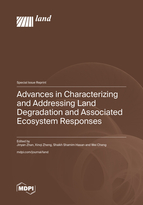Advances in Characterizing and Addressing Land Degradation and Associated Ecosystem Responses
A special issue of Land (ISSN 2073-445X). This special issue belongs to the section "Soil-Sediment-Water Systems".
Deadline for manuscript submissions: closed (30 November 2022) | Viewed by 35358
Special Issue Editors
Interests: land use/cover change; ecosystem services; environmental impact scenario estimation
Special Issues, Collections and Topics in MDPI journals
Interests: urban simulation and geo-spatial modeling
Special Issues, Collections and Topics in MDPI journals
Interests: land use/land cover change; agricultural extension and rural development; sustainable development in agriculture
Special Issues, Collections and Topics in MDPI journals
Special Issue Information
Dear Colleagues,
Climate change and rapid urbanization cause serious problems for the ecosystem, threatening the sustainable development of human societies. The world has experienced dramatic land degradation in recent years, and destructive land use is driving long-term losses of ecosystem function and productivity. Ecosystems provide essential resources that support human survival and wellbeing. Therefore, land degradation greatly impacts socio-economic development. An exploration of suitable pathways and scenarios for urban and rural regional sustainable development is urgently required. The existing literature has been carried out to investigate the temporal and spatial characteristics of land degradation and its negative impacts on ecosystems. However, the research framework, dataset, method and case studies to estimate land degradation and associated ecosystem responses require further exploration. Specific solutions to address land degradation should be proposed and verified to contribute to and ensure regional ecological security.
For this Special Issue, we are interested in contributions that link the ecosystem changes response to land degradation, either via conceptual/theoretical work or empirical research, identifying the characteristics and solutions for sustainable development, including but not limited to:
- Land use and land cover change;
- Land degradation;
- Ecological impacts of urbanization;
- Ecosystem services estimation and simulation;
- Influencing mechanism of land degradation on ecosystem;
- Trend prediction and scenario analysis;
- Spatial modelling and simulation;
- Ecological planning and zoning;
- Nature-based solutions;
- Carbon neutrality;
- Social, economic and ecological coordinated development;
- SDGs and high-quality development.
Contributions in the field of land ecology are especially welcome, but research from other socio-economic fields that benefit the regional sustainable development are also highly welcome. Research regarding multi-scale analysis and field survey is also desired.
Proposed titles and abstracts (250 words) can be submitted by 31 May 2022 to the guest editors, at [email protected], for possible feedback, if prospective authors want some feedback before preparing their manuscripts.
Prof. Dr. Jinyan Zhan
Prof. Dr. Xinqi Zheng
Prof. Dr. Shaikh Shamim Hasan
Dr. Wei Cheng
Keywords
- land use/cover change (LUCC)
- land degradation
- ecosystem function
- ecosystem services
- GIS
- land planning
- Carbon neutrality
- Spatial modeling
- sustainable development









